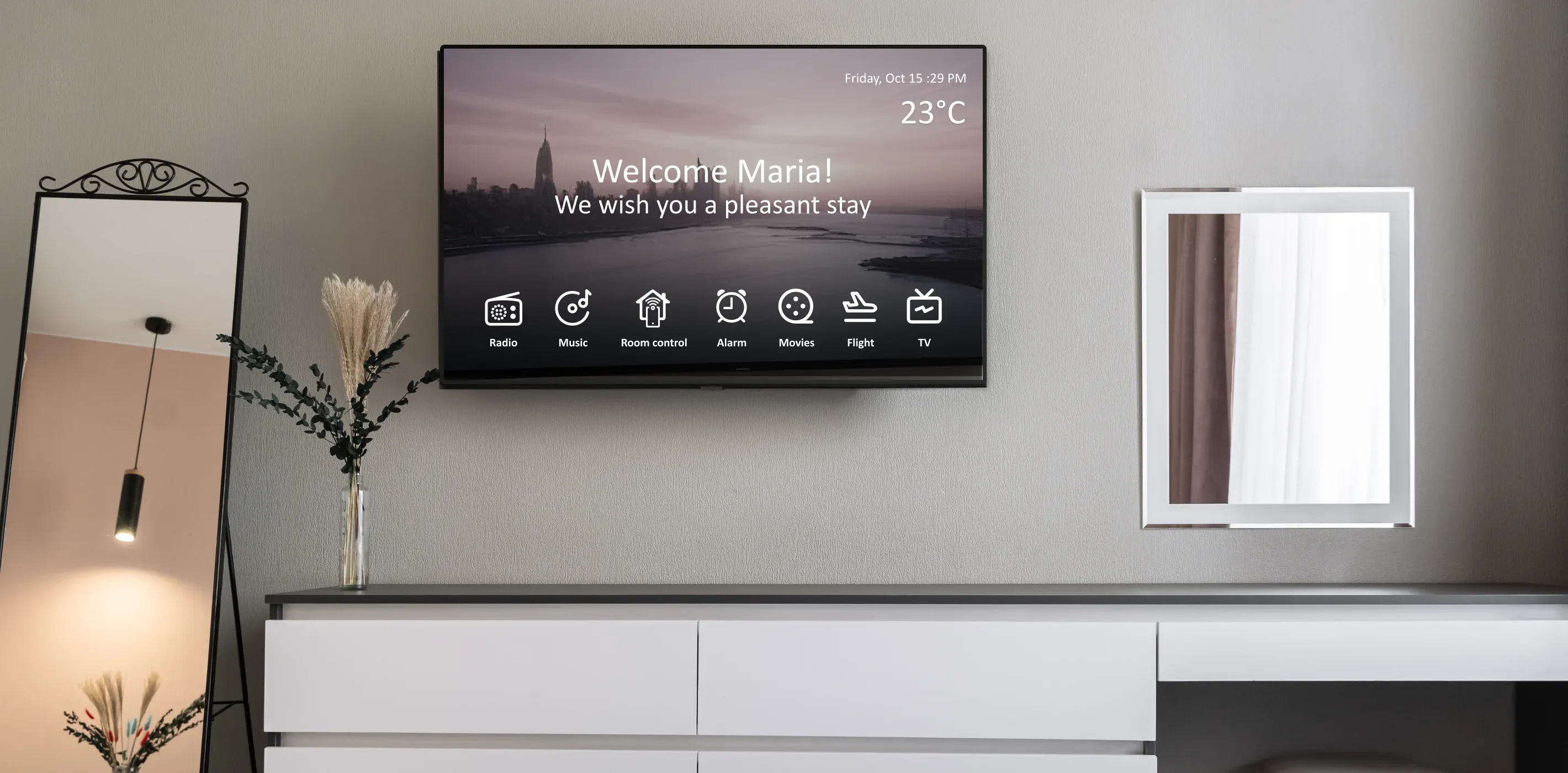

Every hotelier faces the same challenge: How do you increase revenue without simply raising room rates?
For years, RevPAR (Revenue Per Available Room) has been the go-to KPI for hotel success. However, as guest expectations evolve and industry competition intensifies, relying solely on room revenue is no longer sufficient. That’s where TRevPAR (Total Revenue Per Available Room) comes in.
Unlike RevPAR, TRevPAR accounts for all revenue streams, including food and beverage (F&B) sales, spa treatments, event spaces, and in-room upsells.

Note to Hoteliers: Tracking the total hotel revenue, hoteliers can unlock new profit opportunities and maximize overall profitability.
This article is your complete guide to TRevPAR. You’ll learn how it works and why it matters. We also cover key differences to other hotel metrics, actionable strategies, and how you can leverage technology to boost your hotel’s revenue—sustainably.
Total Revenue Per Available Room TRevPAR considers all revenue generated by your hotel, including F&B, spa, events, and more, providing a holistic view of financial performance. It tells you exactly how much money your hotel generates across ALL revenue streams per available room.
Simply said, TRevPAR is the metric that reveals your hotel’s true earning potential.
The formula is as follows:
TRevPAR = Total Hotel Revenue ÷ Available Rooms
The TRevPAR formula considers revenue from all sources, including:
Take a full-service resort, for example, with a total revenue of $750,000 for the month and 300 available rooms over the same period.
$750,000 ÷ 300 = $2,500 in TRevPAR.
This means that for every available room, the resort generated $2,500 in total revenue.
The TRevPAR formula provides a comprehensive understanding of your hotel's ability to maximize revenue—not just sell rooms. Instead of just looking at room occupancy and rates, it allows you to analyze all guest spending behaviors, leading to smarter revenue strategies.
By tracking TRevPAR , hoteliers can make data-driven decisions to increase overall profitability while improving guest experiences and spending habits.
For years, RevPAR (Revenue Per Available Room) and ADR (Average Daily Rate) have dominated hotel revenue discussions.
RevPAR measures the effectiveness of room pricing and occupancy rates. As a combined KPI, it provides insight into overall room revenue performance, considering even unoccupied rooms.
ADR is all about the revenue generated from the rooms you sell. It helps gauge how effectively your hotel is drawing in premium bookings and assesses if your pricing strategy aligns with the perceived value of your offerings.
While these metrics are valuable, neither provides a full financial picture on its own. Unlike ADR and RevPAR, TRevPAR reflects total guest spending habits, making it a more accurate indicator of revenue potential.
| Metric | What It Measures | Formula | Best Use Case |
|---|---|---|---|
| ADR | The average price guests pay per occupied room. | Total Room Revenue ÷ Occupied Rooms | Understanding pricing strategy. |
| RevPAR | Room revenue performance, accounting for occupancy. | ADR × Occupancy Rate or Total Room Revenue ÷ Available Rooms | Measuring room revenue efficiency. |
| TRevPAR | Total hotel revenue per available room (including revenue from all other sources). | Total Hotel Revenue ÷ Available Rooms | Tracking total guest spending and profitability. |
Hotels often lack the tools and processes needed to capture, analyze, and act on TRevPAR insights. Below, we’ll break down the most common roadblocks that prevent hotels from maximizing TRevPAR. Then we’ll provide real-world examples of how leading properties are overcoming them.
Many hotels still operate separate revenue streams for different departments—rooms, dining, spa, and events—which results in disconnected data tracking. Without a single, centralized reporting system, hotels lack visibility into the true revenue contributors of their property. As a result:
The Solution:
To address this, you can use a middleware platform that integrates:
Many hotels rely too heavily on manual upselling, meaning opportunities to increase guest spend are inconsistent and underutilized. Some key roadblocks include:
The Solution:
Hotels can drastically improve TRevPAR by integrating AI-powered upselling strategies, such as:
Many hotels still rely on fixed pricing models, meaning they fail to optimize upsells, F&B services, and ancillary products based on real-time demand fluctuations. Unlike dynamic room pricing, most hotels neglect revenue-driven pricing across other departments, such as:
The Solution:
Hotels can expand dynamic pricing models beyond room rates and introduce optimization for:
Let’s explore actionable ways to increase TRevPAR through intelligent monetization of amenities, services, and guest personalization.
Many hoteliers underestimate just how much more guests are willing to spend if given the right offer at the right time. Strategic upselling and cross-selling ensure that guests don’t just book a room; they book an experience, increasing their overall spend during their stay.
Hotels that actively implement smart upselling techniques can see a 20–35% increase in revenue per guest, directly impacting TRevPAR.
These techniques include:
Personalized Room Upgrades
Instead of simply listing standard vs. premium rooms at checkout, hotels can actively offer room upgrades at key touch points such as:
For example:
A guest books a standard suite, but two days before check-in, they receive an email offering an upgrade to a luxury suite for $50 extra per night, including priority check-in and a bottle of wine.
Food and Beverage Enhancements
Guests are naturally looking for convenient dining options; hotels just need to make them irresistible. Here are some methods to do just that:
For example:
A guest browsing the in-room menu gets a pop-up special offer: 10% off room service for dinner if ordered within the next hour.
Flexible Early Check-In and Late Check-Out Options
Many guests would gladly pay more for check-in or check-out flexibility—yet too many hotels still offer this for free. Hotels can:
For example:
A business traveler with a 9 a.m. flight receives an automatic upsell message: "Extend your stay until 6 p.m. for just $45."
Many hotels significantly underutilize their meeting, banquet, and coworking spaces. These areas can generate profit beyond weddings and corporate events.
With the rise of “bleisure” (business meets leisure) travel and remote work, demand for hybrid meeting spaces, temporary workspaces, and social event venues has increased.
To unlock more revenue from meeting and event spaces, hotels can:
For example:
A hotel with a large event space but limited weekday bookings starts offering corporate hybrid work solutions, booking out spaces for workshops, client meetings, and video conferences during slower periods.
The best way to increase TRevPAR isn’t just to offer more; it’s about offering the right things to the right guests at the right time. Hotels that personalize pre-arrival, in-stay, and post-stay offers based on guest preferences see higher conversion rates and higher per-stay revenue.
Hotels can implement personalization for maximum revenue by:
For example:
A returning guest who previously booked a private guided tour on their last stay automatically receives a promotional pre-arrival message: “Reconnect with the city—book any excursion this time and receive 20% off.”
 To maximize TRevPAR, smart technology is essential for optimizing upsells, streamlining operations, and increasing guest spending. Here’s how hotels can leverage technology to drive higher profits across all departments.
To maximize TRevPAR, smart technology is essential for optimizing upsells, streamlining operations, and increasing guest spending. Here’s how hotels can leverage technology to drive higher profits across all departments.
Hotels often use separate systems for reservations, F&B, spa, and event bookings that don’t communicate with each other. This fragmented data makes it difficult to get a clear overview of total hotel revenue and identify areas for improvement.
Middleware platforms connect PMS, POS, revenue management systems, and guest profiles, enabling real-time revenue tracking and better decision-making.
HotelSmarters’ integrated middleware solution allows real-time revenue tracking, ensuring that every department is strategically aligned to maximize total guest spending across the property.
It allows hotels to view revenue from rooms, dining, spas, and other services all in one place. Staff can access guest preferences and purchase history across departments, while managers can identify high-spending guests and target them with relevant offers.
Most hotels rely on manual upselling at check-in, which is inconsistent and often ineffective. Generic promotions miss opportunities to increase guest spend.
AI-based solutions like revenue management tools analyze guest behavior and preferences to provide personalized upsell offers at the right time. This allows you to:
Guests often don’t know about available hotel services or find it inconvenient to order room service, book spa appointments, or make last-minute upgrades.
Smart in-room technology like interactive TVs, voice-activated assistants, and mobile apps encourage guests to spend more with custom-displayed dining or activity promotions based on guest preferences. One-click purchases encourage higher spending.
Many hotels adjust room rates dynamically but use fixed pricing for other revenue streams, leading to lost profit potential.
Dynamic pricing software adjusts rates for spa treatments, restaurant seating, and event spaces based on real-time demand trends. This allows hotels to:
Note to Hoteliers: Hotels require intelligent, automated solutions to optimize every available room and maximize revenue across multiple channels.
TRevPAR provides a comprehensive view of your hotel’s revenue potential, encompassing not only room sales but also total guest spending. By leveraging smart technology, personalizing guest experiences, and implementing dynamic pricing strategies, hotels can maximize revenue across all departments and drive sustainable profitability.
Looking for more ways to boost your profits? Explore HotelSmarters’ smart revenue-generating solutions or contact our experts to schedule your demo.
Co-founder / CTO
Armen is the CTO and Co-Founder of inoRain OTT and Co-Founder of HotelSmarters, specializing in advanced streaming technologies, OTT strategy, and interactive TV systems. He builds scalable end-to-end video delivery solutions and drives technical innovation across hospitality and streaming platforms, bridging complex engineering with practical business impact.